Perhaps, the most important fact to note about true eels is that some level of salinity is required for their survival. This means that in the strict sense, there are no true freshwater eels that live and breed in freshwaters.
Like many other fish, these eels usually spend their lives in fresh and brackish waters but swim several miles into the ocean to spawn.
However, eels and eel-like fish are noticeably a part of the aquarium trade. If you consider owning an eel aquarium, here is a list of some freshwater eels.
Freshwater Eel Species
Reedfish (Erpetoichthys Calabaricus)

| Care Level | Easy |
| Recommended Tank Size | 30 US gallons (juvenile); 55 US gallons (adult) |
| Water Hardness | 2 – 15 gH |
| Water pH | 6 – 7.5 |
| Water Temperature | 72°F – 82°F |
| Average Aquarium Length | 15 – 20 inches |
The first eel-like fish to consider is the Reedfish. This fish is a peaceful fish that gets along with other fish in the aquarium.
The Reedfish is also called the Rope fish. It is common in Western African countries, including Cameroon, Benin, Nigeria, and Angola.
This eel-like fish can thrive in both freshwater and brackish water aquariums.
It is a curious and friendly fish that usually goes about its business. If you plan to keep this fish, it would be best to keep 2 – 3 of them, depending on the size of your aquarium.
Reedfish can grow up to 20 inches in length. Using a 55-gallon tank or more for a single Reedfish would be best. If you want to keep more than one, a 125-gallon would be best.
Bichir (Polypterus senegalus)

| Care Level | Easy |
| Recommended Tank Size | Not less than 90 US gallons for a single Bichir |
| Water Hardness | 8 – 12 gH |
| Water pH | 6.2 – 7.8 |
| Water Temperature | 75°F – 82°F |
| Average Aquarium Length | 18 – 20 inches |
The Bichir is an air-breathing fish endemic to the Nile River and some surrounding swamps and estuaries. It has a long body with several dorsal finlets.
It is a nocturnal bottom-dwelling fish that grows very fast. This means you have to ensure that your fish tank has enough room.
The Bichir is a semi-aggressive fish. It is one of the common fish you can find in local fish stores.
This fish grows up to 14 inches in length, but in the wild, it can reach a maximum length of more than 23 inches. It is not a true ell, but it has an eel-like appearance. It is, in fact, part of the Polypteridae family.
It is a resilient fish that can tolerate dirty water. It does not demand much care. But if you plan to have them in a community aquarium, it would be better to pick tankmates that are big enough to be respected.
Half Banded Spiny Eel (Macrognathus circumcinctus)
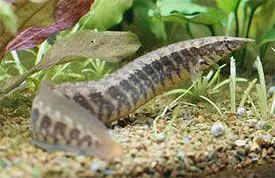
| Care Level | Easy |
| Recommended Tank Size | Not less than 90 US gallons for a single Bichir |
| Water Hardness | 8 – 12 gH |
| Water pH | 6 – 7.5 |
| Water Temperature | 73°F – 82°F |
| Average Aquarium Length | 18 – 20 inches |
Your list of freshwater aquarium eels is incomplete without the Half-Banded Spiny Eel. Unlike the European eel that grows as long as 31 inches in length, Half banded Spiny Eels grow up to more than 8 inches.
Another cool thing about this species of eel is that they are sociable, unlike most freshwater aquarium eels. Keeping about 4 or 5 of them is ideal, and their less than 8 inches length makes this very easy to do.
The Half-Banded Spiny Eel, like Fire eels, is not considered a true eel, even though it has an eel-like body and is called a spiny eel. It is an excellent choice for newbie aquarists who want to start keeping freshwater eels.
Another noticeable thing about the Half banded eel is that it has dark marks over its body, but its marks are better patterned than those on Tire Track Eels. This fish is a great bottom dweller and will make an excellent addition to your freshwater aquarium.
West African Lungfish (Protopterus annectens)

| Care Level | Easy |
| Recommended Tank Size | 55 gallons for a single Lungfish, 75 gallons and above (adults) |
| Water Hardness | 1 – 10 gH |
| Water pH | 6 – 8.5 |
| Water Temperature | 75°F – 86°F |
| Average Aquarium Length | Usually less than 30 inches |
This monstrous eel-like fish is that fish that takes away your worries about getting other fish for the tank. It does not need one.
Also referred to as Tana Lungfish, the West African Lungfish is a lazy and unpredictable eel-like fish in the freshwater bodies of West Africa and some parts of South Africa.
Although ugly as it may be for a freshwater aquarium eel, this Lungfish has some very interesting adaptability features.
One of the most fascinating is its lungs. Unlike electric eels that breathe oxygen by inhaling air with their mouths, the West African Lungfish has two lungs for breathing.
Their lungs supplement their gills which also function as a respiratory organs. With this combination, they are fine in the water and the mud when the water body they inhabit dries out.
Although the largest West African Lungfish caught was more than 36 inches in length, they usually grow smaller than that in captivity.
If you want to keep them as freshwater aquarium eels in your eel aquarium, it would be best to keep them alone. Tankmates are not recommended for this because it has very strong jaws and is unpredictable.
Kuhli Loach (Pangio khulii)
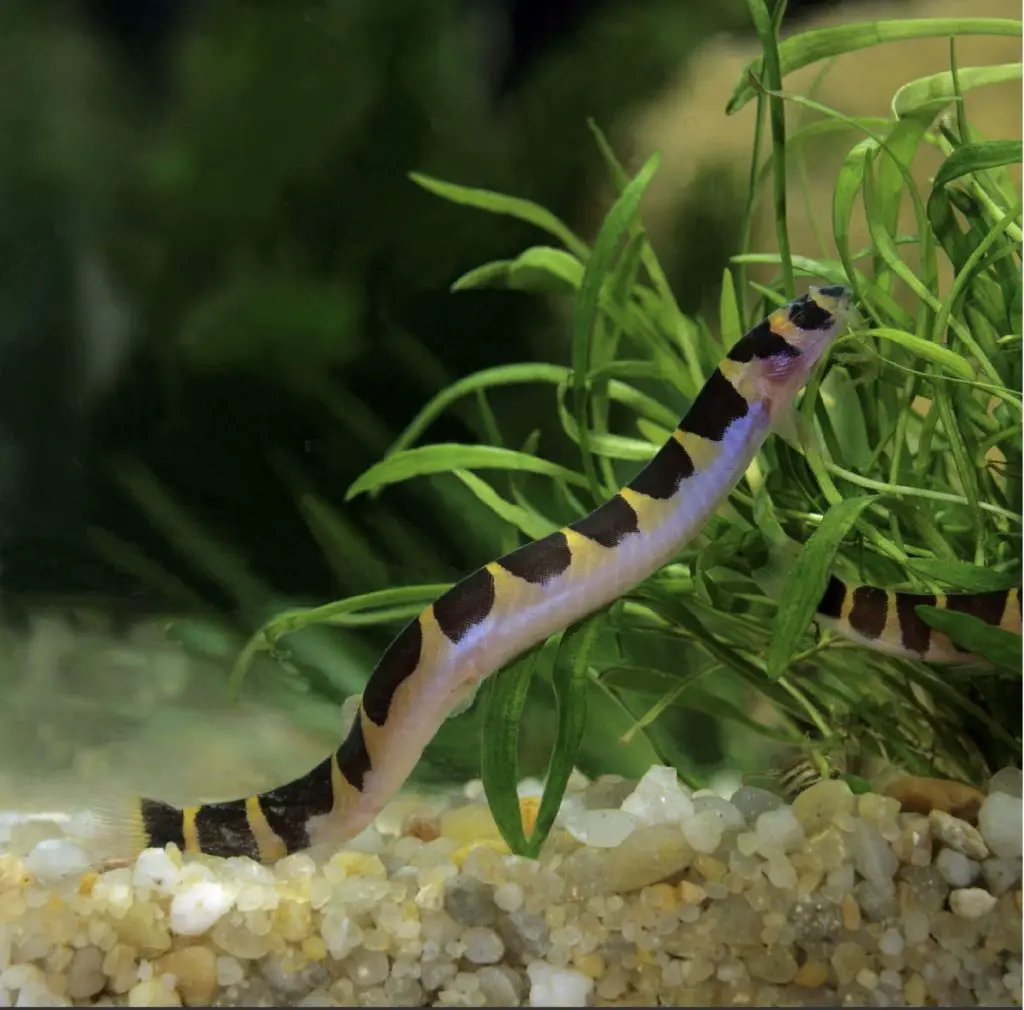
| Care Level | Intermediate |
| Recommended Tank Size | 20 gallons (juveniles), 125 gallons (adults) |
| Water Hardness | 5 – 10 gH |
| Water pH | 5.5 – 6.5 |
| Water Temperature | 76°F – 86°F |
| Average Aquarium Length | 4 inches |
The Khuli Loach is a very popular eel-like fish in the aquarium hobby. This bottom feeder is not a true eel, but its eel-like fish appearance makes it worthy of mention. The Khuli Loach is a popular eel-like fish in the Cobitidae family.
It is one of the many types of freshwater eels that grow to a maximum of only about 4-11 inches in length. But the average size of the Khuli Loach is 2-3 inches. It is a very hardy fish.
Like other spiny eel species, the Khuli Loach has a slender body like a snake’s. It does not have dorsal fins or pectoral fins either. It is so widespread that you can get it in local fish stores wherever you stay.
While most eels are carnivores, the Khuli Loach is an omnivore. It is renowned in the hobby as one of the best cleaner small fish for a freshwater aquarium. This fish usually goes about scavenging for leftover foods at the bottom of the tank.
But you have to specifically feed them so they do not get hungry, as leftovers may not be sufficient to supply their nutrition needs.
You can feed them frozen foods but ensure they sink to the base because this eel-like fish is a bottom dweller. Frozen bloodworms, chicken liver, brine shrimp, etc., will do.
Sinking pellets with plant matter will also work.
Tire Track Eel (Mastacembelus favus)
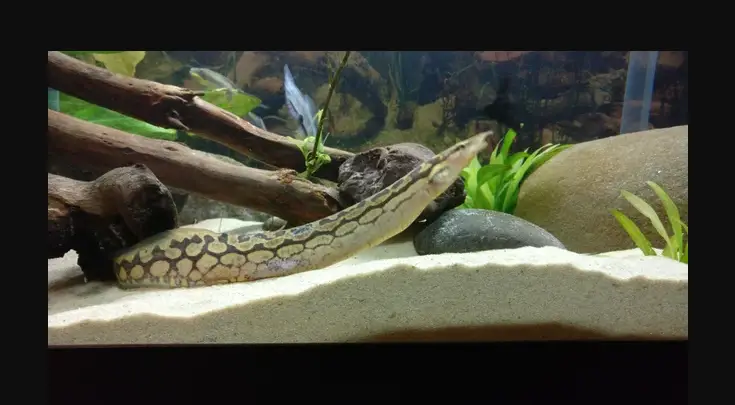
| Care Level | Intermediate |
| Recommended Tank Size | Not less than 35 gallons (juveniles), at least 125 gallons (adults) |
| Water Hardness | 5 – 15 gH |
| Water pH | 6.5 – 8 |
| Water Temperature | 73°F – 82°F |
| Average Aquarium Length | 26 inches |
Sometimes inaccurately called the Zig Zag eel, the Tire track eel is a spiny eel species in the Mastacembelus family. It shares this family with the Zig Zag eel, but both spiny eels belong to different species.
Tire Track eels are renowned for the distinct black marks on their elongated bodies. These marks resemble tire prints, hence the name for this freshwater aquarium eel.
Like most other freshwater aquarium eels, it neither has dorsal fins nor pectoral fins. It only has a slender body to slide off decorations in the eel tank and swim around when it wants to.
Of all the spiny eels, the Tire track eel is perhaps one of the most interesting with its personality. It might be shy and collected when you first introduce it to the eel aquarium; in a matter of time, it will become confident to explore the tank at its pleasure.
Like many other eel-like fish, finding the right cave to accommodate their slender body can be a problem. But you can improvise. You can keep them happy by using long PVC pipes as caves for hiding. The pipe should be long enough to accommodate an elongated fish.
Eeltail Catfish (Plotosus lineatus)
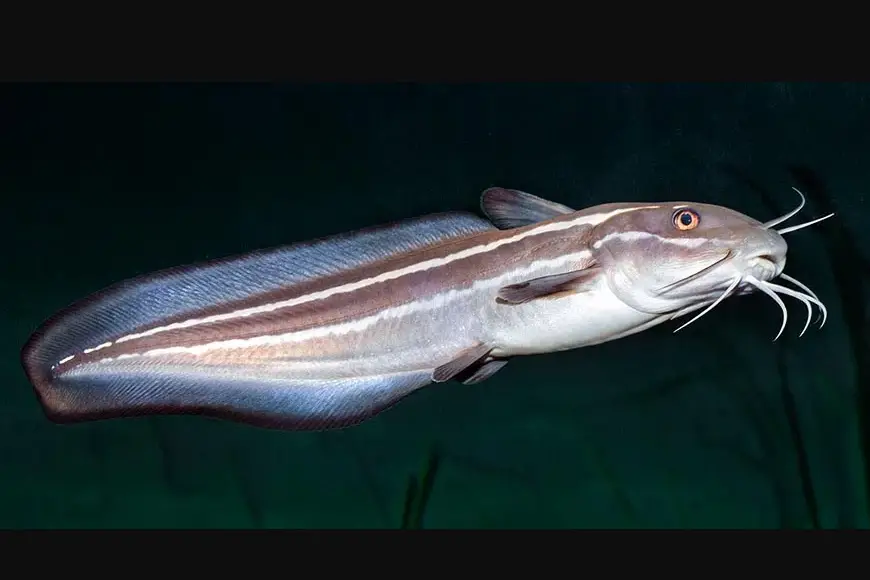
| Care Level | Moderate |
| Recommended Tank Size | 40 gallons (juveniles); 150+ gallons (adults) |
| Water Hardness | 5 – 20 gH |
| Water pH | 6.5 – 7.4 |
| Water Temperature | 60 °F – 77°F |
| Average Aquarium Length | 19 inches |
The Eeltail Catfish (Plotosus lineatus), also known as the Striped Eel Catfish, is not to be confused with the Eel-tailed Catfish (Tandanus tandanus). The Eeltail Catfish is a member of the Plotosidae family, consisting of nine other catfish genera.
The Eeltail Catfish, like many other eel species, has an elongated body. Although it has barbels like a catfish, its eel-like tail complements its elongated body to make it look like a true eel. Its dorsal, caudal, and anal fins merge to form a flowing, continuous fin which gives it an eel-like appearance.
Like many true eels, this carnivorous fish is nocturnal. Although it is not a true eel, this eel-like fish also loves hiding during the day. But it will come out at night to find food and explore the tank.
It uses its barbels to detect food especially when the visibility level of the water is very low.
By dimming the lights, you can trick these freshwater aquarium eels into coming out. That’s a great trick to having them eat.
Electric Eel (Electrophorus electricus)
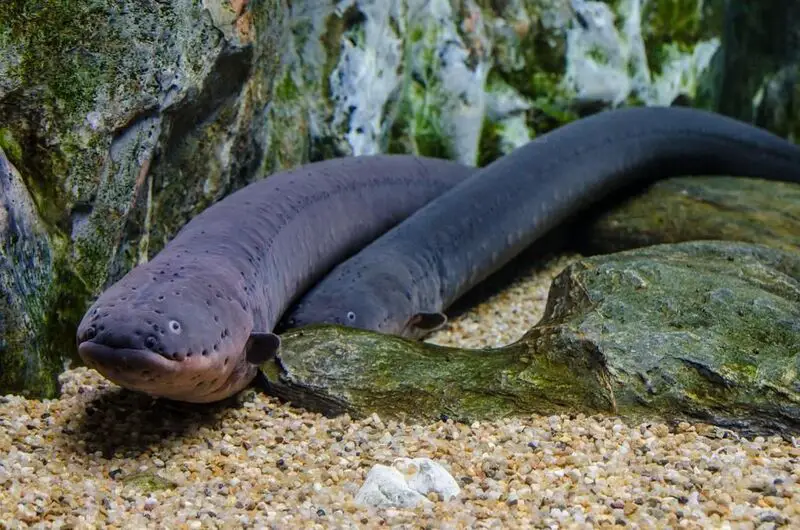
| Care Level | Hard |
| Recommended Tank Size | 100+ gallons (juveniles); 540+ gallons (adults) |
| Water Hardness | 1 – 12 gH |
| Water pH | 5.5 – 6.5 |
| Water Temperature | 73 °F – 82°F |
| Average Aquarium Length | 72 – 96 inches |
Unlike many other freshwater aquarium eels, the Electric Eel is a very deadly fish. This fish can discharge as much as 600 volts when it comes in contact with a predator. It is a very dangerous predator.
When confronted by bigger predators like crocodiles in the Amazon freshwater bodies, it is known to lunge all of its body at the predator.
This tactic allows the electric eel to deliver the maximum electric voltage on its predators, sometimes leaving them stiff to experience momentary respiratory seizures and muscle failure.
The Electrical Eel is not one of the common freshwater aquarium eels in the hobby because of the health risk they pose for hobbyists.
But it is not uncommon to find some daring hobbyists keeping this elongated fish in 200 gallons tanks and more.
One last thing to know about Electric Eels is that although they are eel-like fish, Electric eels are not true eels.
Asian Swamp Eel (Monopterus albus)

| Care Level | Hard |
| Recommended Tank Size | 75 gallons (juveniles); 180 gallons (adults) |
| Water Hardness | 5 – 25 gH |
| Water pH | 6.5 – 8 |
| Water Temperature | 78 °F – 82°F |
| Average Aquarium Length | 9 – 15 inches |
Asian Swamp eels are a very aggressive species of eels that were initially introduced into the US from East and Southeast Asia.
Asian swamp eels are also called Rice Paddy eels. This species of eels is one of the many types of eels that are classified as air-breathing fish.
This swamp eel can grow as long as 36 inches. If you want to keep them as freshwater aquarium eels, a 180-gallon tank or more is what you need for an adult Asian swamp eel.
You want to keep them alone because they are very aggressive. They are so aggressive that you could lose your finger feeding them.
In the wild, an Asian Swamp eel eats a variety of prey. As voracious carnivores, these freshwater eels eat tadpoles, fish eggs, invertebrates, crayfish, worms, and smaller fish.
Peacock Eels (Macrognathus siamensis)
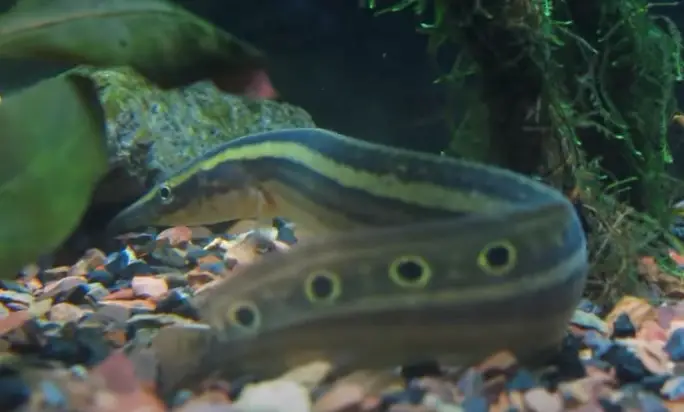
| Care Level | Intermediate |
| Recommended Tank Size | 40 gallons (juveniles); 60+ gallons (adults) |
| Water Hardness | 5 – 15 gH |
| Water pH | 6.5 – 8 |
| Water Temperature | 73 °F – 80°F |
| Average Aquarium Length | 12 inches |
Also known as Spotfin Spiny Eel, Siamese Spiny Eel, and Striped Peacock eel, Peacock eels are not true freshwater eels. But they are on the list of popular freshwater aquarium eels.
The Peacock Eel is a hardy fish with an impressive length like other aquarium eels. But it is smaller than the Electric Eel in terms of length.
This species of eel loves to burrow into the substrate. A soft substrate is a must-have if you want to add them to your community tank.
It is not an aggressive fish. The Peacock Eel is, in fact, a shy fish and will spend time burrowing into the substrate, waiting for the lights to dim so it can come out to explore the tank. You can house this fish with other peaceful fish in your community aquarium.
Fire Eel (Mastacembelus erythrotaenia)
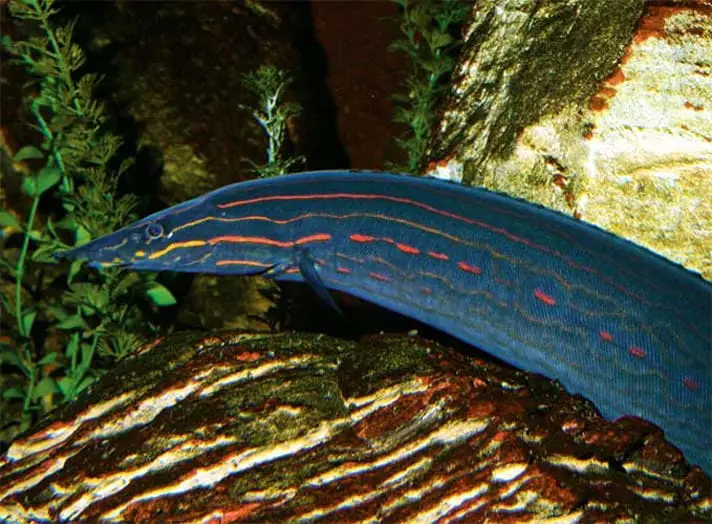
| Care Level | Easy |
| Recommended Tank Size | 180+ gallons |
| Water Hardness | 5 – 15 gH |
| Water pH | 6.5 – 8 |
| Water Temperature | 72 °F – 83°F |
| Average Aquarium Length | Up to 40 inches |
This spiny eel is not a true eel, but the mesmerizing marks on its body make it one of the cool freshwater aquariums eels you will come across.
The Fire eel is a South American fish with a relatively large body and with its signature fire-like markings on its body. The Fire eel can grow as long as 36 inches in the wild, but in captivity, its average length is usually about 20 inches.
Like most freshwater aquarium eels, the Fire eel is nocturnal, active only at night. It will usually bury its elongated body in the substrate away from light and other fish until the nighttime when the lights dim.
You want to leave some food for it before going to bed. You can be sure that it will come out to eat in the night.
Although it is a peaceful bottom-dwelling aquarium eel, it is still a predatory fish. Fire eels can not share the same fish tank with small fish species.
Ideal tankmates for fire eels are fast and mid-level or top dwelling fish that are big enough to be respected. Some you can consider are the Barbs (Medium to large size), Angelfish and Terror fish.
Indian Mud Moray Eel (Gymnothorax tile)
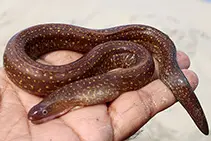
| Care Level | Intermediate |
| Recommended Tank Size | 30 gallons (juvenile); 75 gallons (adult) |
| Water Hardness | 8 – 12 dKH |
| Water pH | 6 – 7.5 |
| Water Temperature | 75 °F – 82°F |
| Average Aquarium Length | 26 inches and less |
This Moray eel is not to be confused with any of the numerous marine moray eel species.
There are over 800 species of eels in the 111 genera under the order Anguilliformes. Most of the moray eels are marine fish, but there are a few freshwater moray eels.
However, many moray eels are also found in brackish waters, and a good example is the Indian Mud Moray eel.
This moray eel is a true brackish water fish, but it can survive in freshwater bodies. However, it will not survive for long in freshwater.
Unlike the marine moray eel species that hide in coral reefs, the Indian Mud Moray Eel is a freshwater moray eel that loves to explore its immediate environment.
It is commonly called the Snowflake Moray eel. Many pet stores may try to sell you the Snowflake eel (Echidna nebulosa) as the Indian Moray eel (Gymnothorax tile).
Take note that the freshwater snowflake eel differs from the Indian Moray eel, even though many pet stores claim they are the same.
Another important thing to remember is that they can jump out of the tank. It would be best to have a lid over the tank.
Zig Zag Eels (Mastacembelus Armatus)
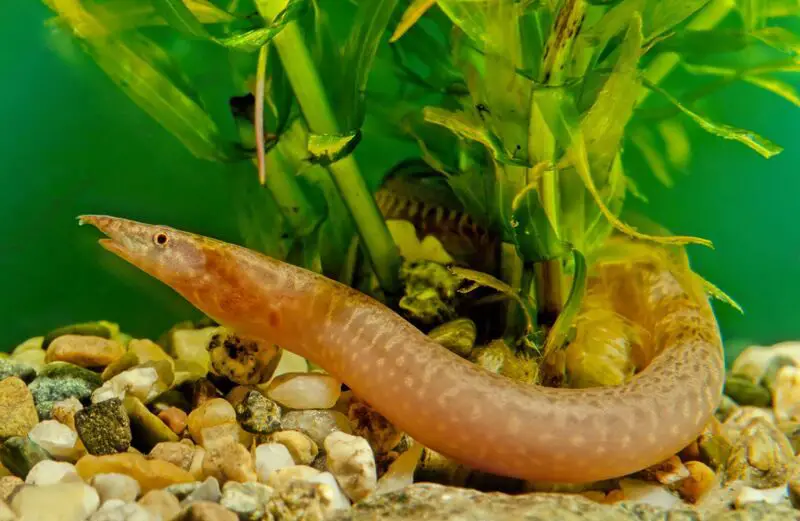
| Care Level | Intermediate |
| Recommended Tank Size | 40 gallons (juveniles); 150+ gallons (adults) |
| Water Hardness | 5 – 15 gH |
| Water pH | 6.5 – 8 |
| Water Temperature | 73 °F – 81°F |
| Average Aquarium Length | 20 inches |
The Zig Zag eel is a species of elongated spiny eels in the genus Mastacembelus. The Zig Zag eel is also inaccurately referred to as Marbled Spiny Eel, Tire Track Spiny eel, and, most commonly, Tire Track eel.
Zig Zag eels are endemic to the riverine fauna of South East Asia. In the aquarium hobby, many aquarists refer to the Zig Zag eel as the Leopard eel.
Although this spiny eel is a bottom dweller, it is an occasional substrate digger. If you are rearing one, you want to use a soft substrate to prevent the possibility of an injury.
The Zig Zag Eel is a true freshwater eel, but it will also thrive in brackish water.
You want to remember that this spiny eel is one of the many types of eels that uproot plants as they burrow into the substrate. It would be best to use floating plants for cover.
Note that this species of eel is similar to the Tire track eel. But major pet stores label them correctly.
It differs from the other eel species in any respect, including their scientific names. The Tire Track eel is Mastacembelus favus, while the Zig Zag eel is the Mastacembelus Armatus.
Freshwater Aquarium Eels Care Guide
There is a lot to consider when taking care of your freshwater eels. However, you want to research the species you are keeping to learn about their specific needs.
Generally, freshwater eels are largely carnivorous. They eat smaller fish, crustaceans, shrimp, daphnia, insects and their larvae, worms at the riverbed, aquatic plants, and small feeder fish.
It would be best to provide them with these food choices to replicate their natural supply.
Some freshwater eels usually eat plant matter, but they do this rarely. You can supplement their meat supply with flakes with plant matter.
You also want to provide a lot of covers for them. Most of these fish species live in swamps and rivers with aquatic plants. They are used to having dim lights. Others are nocturnal and will not be active until the lights dim. So you want to provide lots of covers and plants to replicate their natural environment.
But remember that they are long and slender. Regular covers will e ineffective. You want to provide long and narrow spaces where they can fit in for hiding. Remember to take this into account when picking the tank decor.
It would be best also to ensure that your pump and filters are up to the task. Many of these freshwater aquarium eels breathe with their lungs. You may notice some breach the water surface to gulp air.
So you need a good filtration system to keep the oxygen level in the water constantly at optimal levels.
Another thing to pay attention to is the characteristics of your fish. Some eels are notorious for jumping, especially the species that breach the surface to gulp some air. You want a lid on your tank to prevent them from jumping out of it.
Providing a substrate is not enough. You want to provide a good base with soft sands or granites. Some eel species love to burrow into the substrate while they wait for the night to begin their exploration and scavenging for food.
Since your eels are burrowers, deep-rooted plants will be a poor investment. It would be best to incorporate floating plants in your tank. The floating plants will not only provide oxygen, but they will also provide adequate cover from the light. Another benefit is that the burrowers are less likely to destroy the plants.
Tank Mates for Your Freshwater Eel
There is no straight-jacketed way to go about choosing tankmates for freshwater eels. Some are so peaceful and shy that they make great tank mates for slow-moving and small fish.
Examples of fish like this include the bottom-dwelling Khuli Loach and Ropefish, which explore the substrate and mind their business.
But others are large, bold, and predatory. This means that any small and slow-moving tank mates will be bullied. An obvious freshwater eel that would fit this profile is the Asian Swamp Eel.
This aggressive fish will often reach the tank’s surface for air. While it does this, you can expect it to bully other fish species in the tank. Sometimes, this fish also preys on tankmates that are small enough to be eaten. It will also bite and injure a larger tank mate that is too big to eat.
So there is no uniform approach to choosing tank mates for your fish. You must research the freshwater eel you are keeping to pick the right tankmates.
While Lionfish, Triggerfish, Wrasses, and Tangs are cool choices for a select few freshwater eels that can cope with salt water, these fish species will not cope with the water parameters of a freshwater aquarium. For this reason, they cannot be housed with these freshwater eels.
However, Corydoras, Guppies, Rasboras, and Guppies make excellent tankmates for small peaceful bottom-dwelling freshwater eels like the Peacock eel.
You can consider Wolf Cichlid, Silver Arowanas, and the Blue Umbee Cichlid. These fish species are big enough for your eels to respect. Also, they are largely top and mid-level dwellers. This means the chances of bullying and confrontation are minimal.
Some Tips To Know When Choosing Tankmates for Freshwater Eels
You should know some general information about when picking tank mates for your fish.
- It would be best to choose tank mates with the same temperament level. Peaceful bottom-dwelling fish should be compatible with peaceful mid-level and top-dwelling fish. If your freshwater eel is large, quick, and aggressive, you want to keep it with large and fast tankmates that are equally aggressive.
- When picking tankmates, you also want to ensure that you pick fish species that can survive in freshwater.
- For bigger freshwater eels like the 40 inches Fire eel or the 32 inches Zigzag eel, you need bigger freshwater fish species. You can house bigger eels like these with large predatory fish species.
- Note that not all big freshwater fish can be housed with your eels. Some of these large fish species are prolific waste producers. They are incompatible with some of these eel species that need well-oxygenated water to survive.
- You want to take the time to do your research, taking into account the possible maximum size of your eel, its compatibility with another bottom dweller, its diet, and the tankmate’s rate of pollution.
Are All Freshwater Eels Aggressive Fish Species?
Small-sized eels are usually peaceful, but you still want to be careful when choosing your eel.
But the bigger eels can be intimidating. Since they are naturally predatory, it would be bad to pair small and docile fish species with bigger eels like the Tire Track eels and Fire eels.
Some others have very lethal characteristics that keeping them could be very dangerous. A good example is an Electric eel. Tankmates and owners are equally at risk of electrocution.
The most important thing to do when choosing which eel to rear is to research the eel, its level of aggression, and what you can do to reduce or check its aggression level.
Common Health Issues for Freshwater Eels and Treatment
Unlike most jawed fish that have scales for protection, many freshwater eels do not have scales. This makes them even more susceptible to diseases and infections.
Below are some diseases and infections to watch out for:
- Fungal and Bacterial Infections Leading to Fin RotThis is one of the most common fish health issues aquarists encounter with aquarium fish.Some causes of fungal and bacterial infection include parasitic infections following abrasions and injuries on your eel’s body and constant exposure to poor water quality and diet. Removing the protective mucous on the eel’s body during handling can also lead to bacterial and fungal infections.Symptoms of bacterial and fungal infections include tattered fins, white film on the eel’s body, and open red sores on the eel’s body.You can limit the chances of these diseases by choosing your decorations carefully. You want to avoid rocks and other decoration materials with sharp edges as these could scratch open the eel’s body and make it vulnerable to a fungal and bacterial infestation.Treatment for these diseases is easy. You can treat with antifungal and antibacterial treatment.But first, you want to separate the fish from the community aquarium. Administering any antifungal or antibacterial treatment in the community aquarium could disrupt the aquarium’s water parameters and even cause harm to the biological filters in the tank.
- White Spot Disease (Ich)The white spot disease, also known as Ich, is a very common fish disease. The parasite Ichthyophthirius multifiliis is responsible for this disease. It is a parasitic protozoan that attaches to your eel and penetrates its body to feed on its flesh.It usually appears as a white spot on your eel’s body. It is highly contagious and very adept at replicating itself. After feeding on your eel to maturity, it falls off your eel’s body to the substrate, replicating itself into a hundred more protozoans to repeat the process.The parasite damages your eel’s tissue leaving it vulnerable to bacterial and fungal attacks. It is so contagious that you can be sure all the fish in the community tank have it if you notice it on one of the fish.Symptoms of this disease include white spots on your eel’s body. You may also notice your fish scrubbing itself on solid surfaces in the tank.You need to make the temperature unfavorable for the parasite if you want to treat this disease. You can do this by raising the aquarium water temperature to 82°f for no less than 72 hours. After that, apply an over-the-counter Ich treatment. Finish off with antibacterial and antifungal treatment to help your eel recover from the tissue damage.
Generally, you should watch out for any changes in their habits that seem abnormal. These may include fatigue, lack of appetite, inflammation, and constant rubbing of its body on hard surfaces in the aquarium.
Final Thoughts
Keeping a freshwater eel in your aquarium is a great way to spice up your freshwater aquarium. But this will not be an easy task for a novice aquarist.
Also, not much is known about their breeding. The reason is that they typically swim back into the ocean to spawn.
Photo Credit:
- aquaristsacrosscanada.com
- reddit.com
- monaconatureencyclopedia.com
- Youtube.com
- Be.chewy.com
- Fishbase.de

